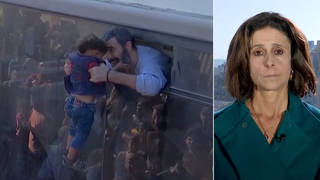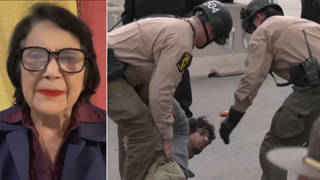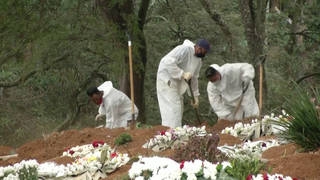
Guests
- Steven ThrasherLGBTQ scholar, social critic, journalist and professor at the Medill School of Journalism at Northwestern University, as well as a faculty member of Northwestern’s Institute of Sexual and Gender Minority Health and Wellbeing.
President Biden declared that “the pandemic is over” during an interview on “60 Minutes” Sunday, despite data collected by Johns Hopkins showing COVID-19 killed 13,000 people across the U.S. over the past month as 2.2 million new infections were reported. “I think it’s very premature to say that we see the end is in sight with this pandemic,” says Steven Thrasher, author of “The Viral Underclass: The Human Toll When Inequality and Disease Collide.” He adds that the sentiment from the nation’s leader is dangerous because it discourages people from wearing masks and seeking booster vaccinations, which are still vital to prevent the virus’s spread.
Transcript
AMY GOODMAN: We begin today’s show looking at the response to President Biden saying the COVID-19 pandemic is over. He said it during an interview on 60 Minutes with CBS’s Scott Pelley.
SCOTT PELLEY: Is the pandemic over?
PRESIDENT JOE BIDEN: The pandemic is over. We still have a problem with COVID. We’re still doing a lot of work on it. It’s — but the pandemic is over.
AMY GOODMAN: Some public health officials criticize Biden’s comments, which come as the White House is pushing people to receive newly reformulated COVID-19 bivalent booster shots. According to data collected by Johns Hopkins, COVID killed 13,000 people across the U.S. over the past month as 2.2 million new infections were reported.
Yale epidemiologist Gregg Gonsalves tweeted, “Sorry folks. Mr. Biden is dead-wrong. 500 people dying per day. 2nd leading cause of death in US. We’re top in mortality among G7. Life expectancy down. He thinks this is good politics. It may be but it’s predicated on accepting the suffering of millions of Americans,” Dr. Gonsalves said.
Meanwhile, Dr. Monica Gandhi tweeted, “What [President] Biden & the [World Health Organization] means ([the WHO] said [the] end [is] in sight last week) is that COVID [is] never over because [it’s] non-eradicable but that [the] emergency phase ends when mortality [is] lower than anytime since March 2020 & when we have biomedical advances,” she said.
For more, we’re joined by Steven Thrasher. He’s the author of The Viral Underclass: The Human Toll When Inequality and Disease Collide. He’s a professor at the Medill School of Journalism at Northwestern University and faculty member of Northwestern’s Institute of Sexual and Gender Minority Health and Wellbeing.
Steven Thrasher, welcome back to Democracy Now! Why don’t you start off by responding to President Biden’s announcement, that surprised many, saying that the COVID pandemic is over?
STEVEN THRASHER: Thank you, Amy.
I was really disappointed and disheartened to hear what the president said, declaring that the pandemic was over. Clearly, the pandemic is not over. Between 400 to 500 people have been dying every day in the United States. We’re just observing 9/11 a week ago. More people were killed in the last week from COVID-19 than were on 9/11.
And, of course, he also said the pandemic — language matters — was over. And this is a global pandemic. It’s global in scale. Although the United States has consistently had a worse rate of death and infection than almost every other country on the face of the Earth, we are just a percentage of the deaths that are happening. And so, about 16,000 people died globally in the last week from COVID-19 around the world. And about 2.5 billion people have not received a single dose of a vaccine. And historically, thinking of HIV and AIDS and other pandemics, HIV and AIDS has been a pandemic now for about 40 years. We still have to deal with pandemics as they go on over time. So, it was narrow-sighted for the president to say that the pandemic was now over, and inaccurate, and really insulting to the millions of people who are sick and dying.
But kind of at a technical level, the thing that I found most surprising is this administration has overly relied upon vaccines as the way to address the pandemic. And vaccines are fantastic. They’ve saved millions of lives. But they have to be used in concert with other things, that the administration has pretty much given up on entirely. And so, it was really surprising, given that we now have this bivalent booster available, that could really match the current circulating strain of COVID-19, and there could be nothing worse to be done to dissuade people from getting that vaccine than to say that the pandemic is over and you don’t need to worry about anything anymore.
JUAN GONZÁLEZ: And, Steve Thrasher, on that note, the message that the president is sending to people as the new booster is being rolled out, and also his noting that more and more people aren’t wearing masks, as if that’s a good thing?
STEVEN THRASHER: Yeah, it’s not a good thing. I mean, we have lots of things that we could be doing to slow down this pandemic, and we need to have a sense of humility about this virus that we don’t know a huge deal about. We don’t know how it’s going to play out over the long term. And so we really need to try to minimize the amount of actual infection that happens. And millions of infections are happening every month.
So, people can wear masks, and people should wear masks. And there’s nothing that’s more difficult in getting people to do it than if the president of the United States says that there’s no need to do so anymore. I really dislike that he sort of said it passively, as if, you know, people just aren’t wearing masks, as if he’s not a leader who could be wearing masks. He’s walking around the Detroit Auto Show without a mask himself. And his administration has tried to do certain things that have been stymied by the courts. Their original order to have people wear masks on public transportation was challenged and struck down by one federal judge, but they didn’t ask for an emergency injunction. They have not fought to keep those things in place. They have not modeled that kind of behavior themselves.
And even under all of this, many of us, myself included, are in institutions and spaces where we’re trying to get people to wear masks, we’re trying to have mask mandates on our campuses or at academic conferences or events that we’re part of. And it makes it almost impossible to do so, to convince organizers that we should take the step, if the president of the United States himself is saying that we don’t need these masks and that they can’t do anything to help.
JUAN GONZÁLEZ: And how does his statement potentially affect his ability to secure billions more that his administration is trying to get from Congress to combat COVID?
STEVEN THRASHER: Well, they’ve been in a failing state on a policy front with the budget since, I think, about March or April, and they originally had a spending bill that combined COVID-19 money — they were asking for about $15 billion — with an aid package for Ukraine. And they pulled them apart, and they still spent the money on Ukraine, and they’ve spent, I think, about $60 billion on Ukraine now. And they’ve largely seemed to have given up on this as a funding priority.
And it’s really important that we get that money for COVID-19. Since March or so, we have not had money to pay for people who don’t have insurance to get COVID treatment, testing as they need it. And research has clearly shown over the past couple years that people without insurance are the most likely to become infected with COVID-19, the most likely to get seriously sick from it and the most likely to die from it. And so we’ve just left those people for dead.
And we’re entering into a situation — we often hear the president and writers in The New York Times and Washington Post often incorrectly talk about how COVID-19 is going to be more like influenza. And it’s a really false comparison that’s being made, and it doesn’t ask an important question, which is: How can we deal with both of these things? And if we dealt with COVID-19 right now, we would actually reduce flu deaths a great deal.
But we’re heading into a situation that is quite predicted by flu, that has really — that potentially could have very dangerous outcomes. You know, for many years we’ve had flu vaccines, and they also work very well. And we see that the people who get them are people who are employed, are people who have jobs with good health insurance and who see a doctor regularly. And if you see a doctor for an annual checkup or twice a year, you’re much more likely to get a flu vaccine, which will protect you, your family and your coworkers. And people who don’t have insurance, who don’t see doctors regularly and don’t get that annual checkup just get flu more often, as do their children and the elderly people in their lives, the people in their workplaces and the people in their homes. And because of that, we see these really stark lines around race and income in who’s more likely to get flu and die from it. And it is — predictably, you know, it’s Black people, Latinx people, poor people and working-class people who are the most likely to get sick from flu and to die from it.
And so, the president is basically setting up this same scenario again with COVID-19. You know, when he has his White House adviser saying that this socially experienced, broadly experienced global health phenomenon needs to be moved into commercial products and needs to move into the commercial private health insurance market, we’re going to see the same kind of outcomes again. People who have health insurance, who see doctors once a year, are going to be much more likely to get their COVID booster, and those who don’t are not, because the Congress has not gotten the money, and the president is not fighting for that money, you know, to get this care to people who don’t even have insurance. And so, this virus is going to pool in what I call a viral underclass, amongst Black people, Latinx people, the uninsured, the poor and the working class. And people in the ruling class and the political class and media elites are going to kind of think things are fine, because they’re getting their booster, even as we’re not doing the work that we need to do to make sure that health equity happens around this pandemic going forward.
AMY GOODMAN: So, Professor Thrasher, what should be done?
STEVEN THRASHER: The most important thing, I think, right now, first, is that the president and the Congress need to get money to get treatment and testing to people who don’t have insurance. That’s already been lost, and we’ve lost a lot of ground around that.
We need to, as aggressively as possible, try to use masks in situations where we can. I had mine on until right before we started rolling here in the studio. And if we didn’t think masks didn’t work, then we would stop using them, you know, in surgical theaters and things like that.
And then we also need to understand that we have to be very proactive about what’s happening with this pandemic. Last week it killed between 400 and 500 people a day in the U.S. It is the second leading cause of death in the United States. There are billions of people around the world who haven’t gotten any vaccines at all. Those are things that we need to address. And we can’t only rely on vaccines.
We need to understand that this is all happening in the context of other health matters, on a lack of Medicare for All. And here in New York state, where we are right now, we’re entering into, I think, our third viral health emergency in as many years. We have the COVID-19 viral emergency, the monkeypox viral emergency and now polio viral emergency. And even though there are distinctions between these different viruses, the root causes around them, you know, the need to act in an interdependent way, the way to have an ongoing vaccine infrastructure, the way that we need to make sure that people have access to healthcare at all times, those things would address all these pandemics. We can’t keep lurching from one to the next to the next.
And as Democrats, like President Biden and Governor Hochul, downplay the need for masks, as David Leonhardt at The New York Times and Leana Wen at The Washington Post downplay the importance of this pandemic, we’re losing ground on COVID-19 and a sense of social responsibility to one another and a need for an ongoing ability to have healthcare for everyone, that’s making each one of these viral pandemics much worse than they need to be and creating needless death and needless suffering.
AMY GOODMAN: Now, it’s not just President Biden who’s saying the pandemic is over. The World Health Organization gave its most upbeat assessment on COVID-19 since declaring the disease an international emergency at the beginning of 2020. WHO Director-General Tedros Adhanom Ghebreyesus said Wednesday the number of newly reported infections has dropped dramatically.
TEDROS ADHANOM GHEBREYESUS: Last week, the number of weekly reported deaths from COVID-19 was the lowest since March 2020. We have never been in a better position to end the pandemic. We are not there yet, but the end is in sight.
AMY GOODMAN: So, if you can talk about that, Steven Thrasher? I mean, he’s talking about a global level. And also talk about how the U.S. has had the highest COVID death toll, followed by India and Brazil. How do you explain this?
STEVEN THRASHER: Well, I think that it’s — obviously, it’s a good thing that death rates are coming down. I think it’s very premature to say that we see the end is in sight with this pandemic. As I was saying earlier, we’re 40 years into an HIV/AIDS pandemic, and that virus still takes about a million lives a year. And we want to be very proactive in making sure everyone gets vaccinated on the Earth and also that countries are doing everything that they can to make sure these levels are low as they need to be.
The United States is in this kind of weird position right now that we’ve seen both with COVID-19 — excuse me — and with monkeypox, in that, historically, when we look at other viruses, it’s typically countries in the Global South, formerly colonized countries, where viruses are finding their way the most easily. And in the past couple of pandemics, and including most recently with polio, we’re actually seeing European countries, formerly colonizing countries, that are having much worse outbreaks with these different viruses. And I think it has a lot to do with the ways that we don’t feel a social responsibility to one another, the ways that we kind of consume travel very easily and have a concept of individual freedom in a way that dismisses the need to act in caring ways towards one another. The United States is about 4% of the world’s population. We’ve had 20 to 25% of the world’s COVID deaths, a huge share of the COVID cases. We’ve had like 35% of the world’s monkeypox cases. And I think that this has to do with our, quote-unquote, “American way of life” and the ways that both political parties will engage these engines that create a viral underclass.
So, you know, for example, you can trace so much of COVID-19 transmission to prison incarceration, and particularly to local jails, with people coming into jails and leaving the jails and coming into the jails and leaving the jails. And as they do, pathogens are moving into the jails and back into their home communities. And the reason why the U.S. has such a higher rate of this respiratory virus has a lot to do with that process. And that process continues across parties. You know, there was a huge rate of incarceration under President Obama, under President Trump and now under President Biden. And when you look at the border, I think The New York Times just reported last night or this morning that we had the first year where 2 million people have been detained for immigration and border enforcement, and jails and prisons around incarcerating people who are legally seeking asylum and trying to get out of dangerous situations, and then putting them into conditions in which viruses move very freely and then are then going to move through their communities, that’s one of the engines that is really driving this pandemic.
And even though the president’s remarks are rightfully being very much debated this morning and are getting a lot of criticism, I think that he is also being informed, and he and the public are both being misled, by high-profile members of the press. And as we see members of the press who had gone after President Trump very critically, understandably and justifiably, a lot of them have not given the same level of criticism to President Biden, when so many things around incarceration and fighting Medicare for All and not delivering on the funding package that we needed for COVID-19, those are — that’s his responsibility. Those are his policies, and those are the things that are driving the pandemic right now. And a lot of the mainstream media has really just not done their job in being critical about those things and saying, “Hey, this is creating the second leading cause of death in the United States, and it’s unacceptable.”
JUAN GONZÁLEZ: And, Steve Thrasher, I wanted to ask you — in terms of the impact of the pandemic on children, many people who are urging return to normalcy say it’s especially important, given the prolonged isolation that millions of children in the United States have had during the past two years, the impact on their future development. What is the alternative, in terms of, on the one hand, protecting the population; on the other hand, allowing children to develop as normally as possible?
STEVEN THRASHER: Well, there’s a lot of bad information about how this pandemic has affected children. And, of course, people of all ages have been affected terribly by this pandemic. Children’s learning development is not impeded by wearing masks. Dr. Leana Wen has written that in The Washington Post. And that really points out something I think is really insidious and really ableist about lots of the ways that we think about viruses and children, is that it has an ableist framework. Leana Wen is claiming that masks will make children unable to learn. It’s not true. Children who are blind develop language at the same rate as sighted children. The roots of the anti-vax movement in the United States have to do with this misnomer, that’s completely incorrect, that vaccines will cause autism. And the thinking is sort of that if children — you know, parents would rather have their children potentially get something that could kill them, like measles, rather than face the possibility of having a disabled child. And so, the framework is really off.
And I think a lot of the worry about children comes from this very ableist way and sort of these unnecessary places of worry, when, in fact, children need to be — you know, they do need to socialize, they need to be with other children, and if they wear masks, they’d be more able to do so safely. If their classrooms had really good ventilation, and if local governments had not been spending their federal money for COVID on police, and had been spending it again — instead on ventilation, they’d be more safely able to do so.
But I think that we cannot just isolate and look at things like test scores and say that it was school closures that made test scores come down — and test scores themselves are not the greatest metric for learning anyway. But we can’t just look at those things. We have to also look at what the past two-and-a-half years have done. And children and their parents have been put in great economic precarity. They’ve been facing eviction. They’ve not known for month to month whether or not they’re going to get kicked out of their homes. They’ve been facing enormous food security. And hundreds of thousands of children in the United States and millions around the world have become orphans. They’ve lost their primary caregiver. And research has long shown that nothing is more devastating to children, economically, emotionally, often even physically, than becoming an orphan and losing one of their primary caregivers.
And so, yes, you know, we want children to be together as safely as possible. That’s why we need to mask and ventilate and get vaccination as often as possible. But there are ways that children need to be protected from the death of a loved one and the death of themselves. COVID has been, you know, a very big killer of children, among the things that actually kill children. And so, we can’t just talk about lockdowns or think about the harm that comes from lockdowns, but also admit that this is a virus that could potentially have lifelong effects for children, and we need to have a sense of humility as we study that, and decrease transmission as much as possible. And we also need to make sure that they, their teachers, their janitors, their parents and grandparents are safe, because you need to be able to raise them. And all of the people in the children’s lives need to have enough food and housing security to be able to raise them in a way that’s going to allow them to flourish. We can’t just focus only on school — we can’t just focus on the potential of school closures. And we must look at everything it takes to keep children safe around this virus and in the totality of their lives.
AMY GOODMAN: Finally, Steve Thrasher, your Scientific American piece titled “Monkeypox Is a Sexually Transmitted Infection, and Knowing That Can Help Protect People,” if you can elaborate, before you go?
STEVEN THRASHER: Certainly. So, I’ve been — like many of my colleagues who worked on HIV and AIDS, we pivoted quickly to COVID, and then many of us also pivoted to studying monkeypox this summer. And one of the things that I found surprising a bit was that it seemed pretty clearly to those of us who study these things that there was a mutation in this virus in the last few years and that a lot of the transmission — the majority of the transmission was happening sexually, primarily through men who have sex with men. And this was a deviation from how monkeypox had been studied and understood to exist, but needed to be addressed. To me, there was nothing embarrassing about it. And I thought, unlike COVID-19, you know, we needed to have really, really clear conversations with our audiences, with our colleagues, students, people in our lives, to address that that’s what — this is how this virus was moving.
And it was important to do so, one, because we didn’t have enough of the vaccine, and we didn’t want people who were not really in the pathway of this virus and how it could potentially move to be getting the vaccine, when we knew the people who were most in the pathway of it. And I also think it was important to talk about this because we wanted to reduce stigma in ways that didn’t need to happen. So, for example, if this virus is primarily moving sexually, people don’t need to worry about being on a subway with someone who is gay. They don’t need to worry about dorming with them or being in a classroom with them. It’s not moving kind of respiratorally in this way, certainly not the way it did with COVID-19. People do need to wear masks for COVID-19 when they’re in these settings, but they don’t need to wear them for monkeypox.
And so, I thought it was really important to name this and try to deal with some of the problems that we had and the lessons that we learned in COVID-19 about being as honest with the public as quickly as possible with the best information that we had. So, I thought we really needed to name that. And I’m incredibly proud of the work that LGBTQ organizations have done, that groups of queer men have done, that sex clubs and saunas and gay community centers and all kinds of public health people have really just done a tremendous effort over the summer getting to members of the LGBTQ community, getting people vaccinated, trying to help people understand this under very, very difficult circumstances. And it’s starting to become a success story as the rates come down.
AMY GOODMAN: And finally, Steve, do you agree with the efforts to rename it? California public health officials renaming monkeypox “mpox,” they say the term “monkeypox” is a misnomer, its animal reservoir rodents, not monkeys. It’s led to racist stigmatization. The WHO is also looking to rename monkeypox.
STEVEN THRASHER: I agree with the sentiment. I think the window kind of closed. The WHO talked about doing this like three, four, five months ago, and I think that they should have done so at the time, because it’s very difficult to do so now. But I understand the reasoning behind it. I support it. And if colleagues of mine or publications or organizations ask us to stop using the phrase, I will do so. I tried doing that at the beginning of the summer. It wasn’t really picked up by others, and it kind of just moved into the language. But I understand the reasoning behind it. And it’s an important distinction to make, and to always use the language we can that is the least stigmatizing and welcomes people into the process of getting help and knowing that they’re not going to face any kind of punishment or stigmatization if they get help for their medical needs.
AMY GOODMAN: Well, Steven Thrasher, we don’t want you to miss your plane, author of The Viral Underclass: The Human Toll When Inequality and Disease Collide, professor at the Medill School of Journalism at Northwestern University, faculty member of Northwestern’s Institute of Sexual and Gender Minority Health and Wellbeing. Thanks so much for joining us.
Next up, the White House has denounced the Florida governor and Texas governor’s busing and flying asylum seekers to places like Martha’s Vineyard. The asylum seekers say they were lied to. They didn’t know where they were going. Is this modeled on the Reverse Freedom Rides of 1962 that Southern segregationists sponsored, busing Black families to Cape Cod? Stay with us.












Media Options